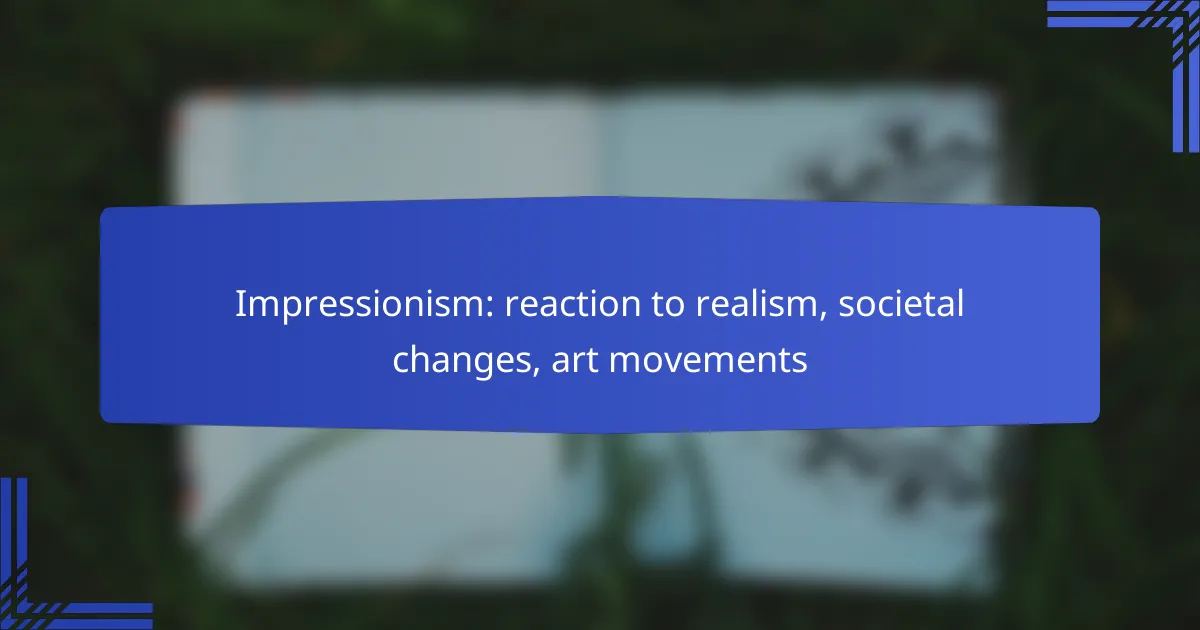Impressionism emerged as a reaction to Realism, emphasizing personal perception and the emotional experience of a scene rather than strict accuracy. Influenced by societal changes such as the Industrial Revolution and urbanization, artists began to explore modern life and the transient nature of experience. This innovative movement laid the groundwork for subsequent art movements, including Post-Impressionism and Fauvism, each responding to the principles established by Impressionist artists.

How did Impressionism react to Realism?
Impressionism emerged as a response to Realism by prioritizing personal perception over objective representation. While Realism focused on depicting everyday life with accuracy, Impressionism sought to capture fleeting moments and the emotional experience of a scene.
Focus on subjective experience
Impressionism emphasizes the artist’s personal interpretation of a scene rather than a strict representation of reality. This subjective approach allows for a more emotional connection between the artwork and the viewer, inviting them to experience the moment as the artist did.
Artists like Claude Monet and Pierre-Auguste Renoir often painted en plein air, or outdoors, to capture the essence of a moment, reflecting their immediate feelings and impressions rather than adhering to realistic details.
Emphasis on light and color
Impressionists placed significant importance on the effects of light and color in their works. They experimented with vibrant palettes and loose brushwork to convey the changing qualities of light throughout the day.
This focus on light led to innovative techniques, such as using complementary colors side by side to create a sense of vibrancy and movement, which was a departure from the more muted tones of Realism.
Departure from traditional techniques
Impressionism marked a shift away from the meticulous techniques of traditional painting, such as smooth brushwork and detailed backgrounds. Instead, artists employed quick, short strokes to capture the essence of their subjects.
This departure allowed for a more spontaneous and dynamic representation of scenes, often resulting in a sense of immediacy and movement that was absent in Realist works.
Influence of photography
The advent of photography in the 19th century significantly influenced Impressionist artists. Photography provided a new way to capture reality, which led painters to explore more abstract and interpretive approaches to their subjects.
Impressionists often embraced the spontaneity of photography, using it as a tool to study light and composition, which further encouraged their departure from traditional artistic conventions.
Rejection of historical subjects
Unlike Realism, which often depicted historical events or significant social issues, Impressionism largely focused on everyday life and ordinary moments. This rejection of grand narratives allowed artists to explore more intimate and personal themes.
By concentrating on scenes from daily life, such as leisure activities and landscapes, Impressionists highlighted the beauty in the mundane, inviting viewers to appreciate the world around them in a new light.

What societal changes influenced Impressionism in Britain?
Impressionism in Britain was significantly influenced by societal changes such as the Industrial Revolution, urbanization, and shifts in social structures. These transformations created a new environment for artists, prompting them to explore themes of modern life and the fleeting nature of experience.
Industrial Revolution impact
The Industrial Revolution drastically altered Britain’s landscape and economy, leading to rapid advancements in technology and manufacturing. Artists began to depict the effects of industrialization, showcasing bustling factories, steam trains, and the stark contrasts between urban and rural life. This shift encouraged a focus on capturing the transient moments of everyday life, a hallmark of Impressionism.
Urbanization and social mobility
As people migrated to cities for work, urbanization brought about significant social changes. The rise of cities like London created new opportunities for artists to explore diverse subjects, from street scenes to public parks. This urban environment fostered a sense of social mobility, allowing artists to engage with a broader audience and reflect the changing dynamics of society.
Changing roles of women
The late 19th century saw evolving roles for women in Britain, with more women entering the workforce and pursuing artistic careers. This shift allowed female artists to gain visibility and contribute to the Impressionist movement, often portraying themes of domestic life and the female experience. Their perspectives enriched the movement, emphasizing the importance of personal and emotional expression.
Rise of the middle class
The emergence of a prosperous middle class during this period provided new patrons for artists and a growing audience for art. This demographic shift led to an increased demand for artworks that depicted contemporary life, leisure activities, and the beauty of everyday moments. Impressionist artists catered to this audience by creating accessible, relatable works that resonated with the experiences of the middle class.

Which art movements are associated with Impressionism?
Impressionism is closely linked to several art movements that emerged in response to its innovative techniques and philosophies. Key movements include Post-Impressionism, Fauvism, Expressionism, and Modernism, each building upon or reacting to the principles established by Impressionist artists.
Post-Impressionism
Post-Impressionism developed in the late 19th century as a reaction to Impressionism, emphasizing emotional expression and symbolic content. Artists like Vincent van Gogh and Paul Cézanne sought to explore deeper meanings through color and form, moving beyond the fleeting effects of light that characterized Impressionism.
This movement is notable for its diverse styles, with some artists focusing on geometric forms while others embraced vivid colors and emotional depth. The emphasis on personal expression laid the groundwork for many modern art movements that followed.
Fauvism
Fauvism emerged in the early 20th century, characterized by bold, non-naturalistic colors and a strong emphasis on painterly qualities. Artists such as Henri Matisse and André Derain were known for their vibrant palettes and simplified forms, which were influenced by the color theories of Impressionism but took them to new extremes.
The movement was short-lived but significant, as it challenged traditional representations of color and form. Fauvism’s approach encouraged artists to prioritize emotional resonance over realistic representation, paving the way for future explorations in color theory.
Expressionism
Expressionism arose in the early 20th century, focusing on representing emotional experiences rather than physical reality. Artists like Edvard Munch and Wassily Kandinsky used distortion, exaggeration, and bold colors to convey feelings, often reflecting societal anxieties of the time.
This movement diverged from Impressionism by prioritizing the artist’s subjective experience over the depiction of light and atmosphere. Expressionism’s exploration of inner emotions influenced various subsequent movements, including Abstract Expressionism in the mid-20th century.
Modernism
Modernism encompasses a broad range of artistic movements that emerged in the late 19th and early 20th centuries, including Impressionism, Post-Impressionism, and others. It is characterized by a break from traditional forms and a quest for new ways to express the rapidly changing modern world.
Modernist artists sought to capture the essence of contemporary life through innovative techniques and materials. This movement reflects the complexities of modern existence, often embracing abstraction and experimentation, which can be seen as a direct evolution from the foundations laid by Impressionism.

What are key characteristics of Impressionist art?
Impressionist art is characterized by its emphasis on capturing light and movement through loose brushwork and a focus on everyday scenes. This movement emerged as a reaction to the detailed realism of earlier art forms, reflecting societal changes in the late 19th century.
Loose brushwork
Loose brushwork is a defining feature of Impressionist art, allowing artists to convey the fleeting effects of light and atmosphere. Instead of meticulous detail, Impressionists used quick, visible strokes that create a sense of spontaneity and immediacy.
This technique often results in a textured surface that invites viewers to engage with the painting from a distance, where the individual strokes blend together to form a cohesive image. Artists like Claude Monet and Pierre-Auguste Renoir exemplified this approach, using vibrant colors and dynamic brushwork to evoke emotion and movement.
Focus on everyday scenes
Impressionist artists shifted their attention from grand historical or mythological subjects to everyday scenes, capturing moments from daily life. This focus on ordinary activities, such as people enjoying leisure time in parks or bustling city streets, reflects the changing social dynamics of the time.
By portraying common experiences, Impressionists aimed to connect with viewers on a personal level. This approach not only democratized art but also highlighted the beauty in the mundane, encouraging audiences to appreciate their surroundings in new ways.
